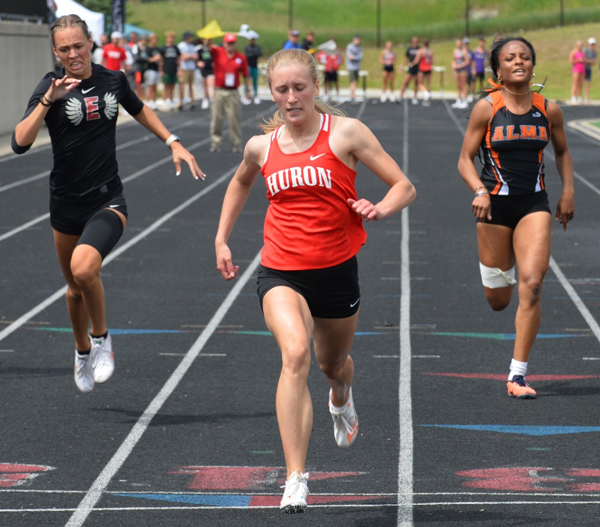
MHSA(Q&)A: Norway track champion Dani Gagne
June 7, 2012
 By Brian Spencer
By Brian Spencer
Second Half
Norway senior Dani Gagne might not be a familiar name among the Lower Peninsula track and field community. But in the Upper Peninsula, she's built a legacy that will be talked about for years to come.
Gagne won four Upper Peninsula Division 2 championships Saturday, giving her 10 MHSAA championships total for her high school career. She set a UP Division 2 Finals record in the 200-meter dash of 26.42, and also won the 100 (12.62), 400 (1:00.65) and long jump (15-foot-9).
Gagne also played volleyball and basketball at Norway. She's signed to run at Hillsdale College next season.
What sort of camps did you attend to get your times down?
I only went to one camp, and that was in 2009. The camp was held at the University of Michigan. They gave us pointers on good technique, how to move your hands when running, and how to get a good start from the blocks. I found that the advice that I got from the blocks was most worthwhile and helped me this past season the most.
What was the best advice you’ve received to help you reach the success that you have with track?
Well, there was this one guy (track coach from Loyola), who said I should look at everybody else as if they were in my race, and to visualize owning the race; make the race my own to win or lose.
What other colleges were you thinking of and how did you decide to go to Hillsdale?
I was looking at schools like Michigan Tech and Lake Superior State for track. I am glad that I decided on Hillsdale, though, and am excited for the experience to begin.
Who’s your favorite athlete and why?
Well, I’ve never thought about this much, but if I had to choose, Lori (Lolo) Jones is probably my favorite athlete. She’s a good runner. (Jones is a U.S. Olympian and was an NCAA champion hurdler at Louisiana State University).
How much did your back injury affect your events?
I suffered from an SI (sacroiliac) joint discomfort. It wasn’t a terrible injury, however, I did notice it a little bit when I ran. I noticed it more when I did the long jump. Jumping wasn’t terrible, but when I hit the sand, that’s when I was reminded that my back was uncomfortable the most.
What are you going to study at Hillsdale?
Exercise science.

PHOTO courtesy of the Gagne family.

Multi-Sprint Champ Racing to Finish Huron Career Ahead of the Rest Again
By
Keith Dunlap
Special for MHSAA.com
May 25, 2023
NEW BOSTON – If there was one thing Elizabeth Anderson took pride in elementary school, it was simply showing that she could outrun everyone in sight.
 In fact, Anderson has an explanation for all the success she had in those playground races.
In fact, Anderson has an explanation for all the success she had in those playground races.
“Dominance when you are in elementary school,” Anderson quipped. “I don’t think I ever had a nickname. I just think everyone knew I was fast.”
Years later, pretty much everyone who follows track & field in the state of Michigan can attest to that.
A senior for New Boston Huron, Anderson has been faster than most other competitors in the state during her three-year high school career (with her freshman season in 2020 canceled due to COVID-19).
Last year, Anderson won titles at the Lower Peninsula Division 2 Finals in the 200-meter (25.07) and 400-meter (56.28) dashes, and was runner-up in the 100-meter dash (12.23).
Often, top sprinters focus on one or two of those three races. But Anderson is certainly a different breed of sprinter because she does all three.
In fact, she holds school records in all three of those events, and if all that weren’t enough, Anderson is a part of all three sprint relay teams.
“It is hard to give her events off,” said New Boston Huron head girls track coach Danielle Lobato.
Despite the different styles the 100, 200 and 400-meter dashes present, Anderson said there usually isn’t much adjusting when she goes from one of those races to another.
 The strategy is simply, “Let’s beat the other girls to the finish line.”
The strategy is simply, “Let’s beat the other girls to the finish line.”
“I don’t really go into each race changing up how I would run,” she said.
While enjoying and succeeding in all three races, Anderson said she actually does have a favorite among them.
“I would say the 400 is probably my favorite,” she said. “Even though it hurts, it’s satisfying to see how much you can get your time down in the 400 compared to any other race.”
Anderson said she started running track in sixth grade, but really got serious about it during the summer after her sophomore season, when she was invited to run for a local club.
Eventually, that led to her competing over the winter in indoor events.
She lived and breathed track so much that last fall, she decided to not run cross country so she could focus on a weightlifting regimen aimed at developing more leg strength.
“Once I started doing summer track, I realized I wanted to be doing this all the time,” she said.
Lobato said oftentimes in practice, Anderson is a de facto coach, given there is no better person she can think of for the younger runners on the team to learn from.
“I can’t always demonstrate these things I’m trying to teach,” she said. “You get to see it in real life (from Anderson), not in a YouTube video.”
After winning the 100, 200 and 400-meter dashes at her Regional meet last week, Anderson has her sights set on achieving the same trifecta of titles at next Saturday’s Finals in Grand Rapids.
Anderson has signed to run track at Michigan State, but has been plenty motivated to keep producing this spring in her final high school season.
“I’m really looking to defend my titles,” she said. “That is what is really motivating me to keep going. I want to keep in shape for the college season. I don’t want to lose any of the progress I have made. Ultimately, I just love running track.”
And since elementary school, Anderson has loved — and succeeded in — outrunning everyone else to the finish line.
“We knew we were getting something special,” Lobato said of when Anderson arrived in high school. “But you never expect this. All that she has accomplished is amazing.”
 Keith Dunlap has served in Detroit-area sports media for more than two decades, including as a sportswriter at the Oakland Press from 2001-16 primarily covering high school sports but also college and professional teams. His bylines also have appeared in USA Today, the Washington Post, the Detroit Free Press, the Houston Chronicle and the Boston Globe. He served as the administrator for the Oakland Activities Association’s website from 2017-2020. Contact him at [email protected] with story ideas for Oakland, Macomb and Wayne counties
Keith Dunlap has served in Detroit-area sports media for more than two decades, including as a sportswriter at the Oakland Press from 2001-16 primarily covering high school sports but also college and professional teams. His bylines also have appeared in USA Today, the Washington Post, the Detroit Free Press, the Houston Chronicle and the Boston Globe. He served as the administrator for the Oakland Activities Association’s website from 2017-2020. Contact him at [email protected] with story ideas for Oakland, Macomb and Wayne counties
PHOTOS (Top) New Boston Huron's Elizabeth Anderson clears the finish line during last season's LPD2 400 race. (Middle) Anderson, middle, outpaces the field to also win the 200. (Click for more from RunMichigan.com.)

